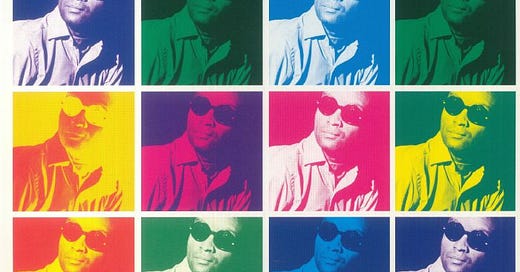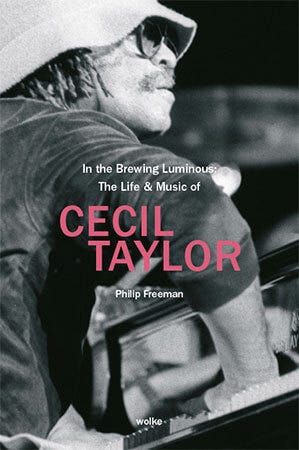Rabble Without A Cause, February 19: Cecil Taylor - the Blue Note releases
In this third show celebrating Black History Month, I will be featuring Cecil Taylor's two releases on Blue Note from the mid-60s, based on a new biography
Philip Freeman has written a comprehensive overview of the career of pianist and composer Cecil Taylor, In the Brewing Luminous: the Life & Music of Cecil Taylor. On this show, I will be drawing on the part of the book that discusses his two recordings for Blue Note Records in 1966.
The first album, Unit Structures, was recorded on May 19, 1966. The recording included:
Jimmy Lyons (alto sax)
Henry Grimes (bass)
Andrew Cyrille (drums)
Eddie Gale (trumpet)
Ken McIntyre (alto sax, oboe, and bass clarinet)
Alan Silva (bass)
The album was recorded by Rudy Van Gelder at his famous studio. Freeman writes that Van Gelder prioritized the horns and the two basses,
giving the album the feel of chamber music … but it lacks the dry perfection of a classical recording. The piano often sounds like it was recorded over the phone, losing the extraordinary precision of Taylor’s attack. Similarly, Cyrille’s drums do not have the crispness that best showcases his style, becoming a kind of hiss and gentle rattle in the background.
Freeman refers to the tremendous energy on this album, “without a sense of abandon”. Alan Silva said in 2002 that the album took four months of rehearsal.
The liner notes for Unit Structures included a lengthy essay by Taylor, entitled “Sound Structure of Subculture Becoming Major Breath/Naked Fire Gesture”, that Freeman describes as an exploration of Taylor’s creative philosophy and compositional approach “through dense thickets of poetic metaphor”.
On October 6, 1966, Cecil Taylor returned to the Van Gelder studio to record Conquistador! On this recording, the usual grouping of Taylor, Lyons, Grimes, Silva, and Cyrille was joined by Bill Dixon on trumpet.
This album contains just two tracks — “Conquistador” and “With (Exit)”. Freeman describes the first side of the album:
“Conquistador” is a suite of sorts. It begins with a hard-driving, percussive section lasting about five minutes, during which Dixon is not heard at all; Lyons takes an extended, bluesy solo as Taylor and Cyrille lay down a bed of spiky gravel beneath him. But then, as if by some signal unnoticed by the listener, the music seems to stop dead as Dixon begins to emit long, still phrases, totally perpendicular to everything that’s come before. The piano becomes delicate, even mournful; the drums virtually disappear; bowed, cello-like drones are heard from Silva’s bass; and Dixon maintains an icy calm for two and a half minutes, as though stilling a classroom full of restive children. It’s a stunning act of dominance, the musical equivalent of a coup d’état. When the piece resumes, the two horns play an almost Ornette Coleman-esque unison line that’s one of the most beautiful melodies in Taylor’s discography, before the pianist begins his own extended solo, hovering at the keyboard’s low end and meditating on repetitive, cellular phrases until they crack open like walnuts.
Freeman continues with a description of the second side:
The album’s second track … does not have the same multi-part structure as the first. It begins with a short piano phrase, then a passage for the two horns, with Silva’s high-pitched, bowed bass providing a third voice, almost like a singer. Dixon drops away very quickly, leaving Lyons to trade phrases with Taylor, but eventually he too disappears, and the piece becomes a meditative quartet, with Taylor playing extraordinarily slow, gentle, romantic figures and Silva sawing at his instrument’s neck. Around the four-and-a-half minute mark, Dixon comes in, seemingly trying to disrupt things with long, patient phrases as he did on “Conquistador,” but no one’s biting, so eventually he begins emitting squiggling ejaculations as Taylor and Cyrille pound away. Lyons gets a solo, too, and then there’s a long trio section in the piece’s final third, before the horns return for a reiteration of the theme.
On the show I will play selections from Unit Structure and all of Conquistador. These were the only two studio recordings that Cecil Taylor did for Blue Note.
However, in 1985 Cecil Taylor performed at a Blue Note all-star reunion concert which is included on the album, One Night With Blue Note - Volume 2. Here he is playing “Pontos Cantados”.
You can listen live on Wednesday, February 19 at 11 p.m. at 93.1 on the FM dial or online at CKCUFM.com. The show will also be available on demand.






